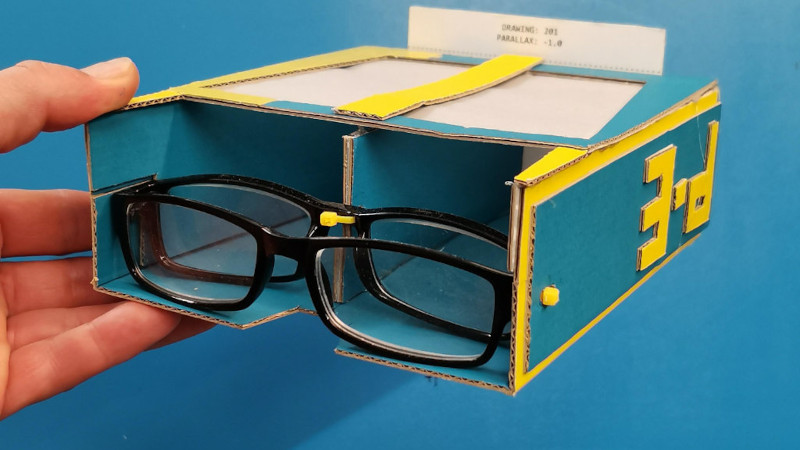It’s an unfortunate consequence of growing older, that no longer are you able to read the print on a SOT-23 package or solder a QFN without magnification. Your eyes inexorably start to fail, and to have any hope of continuing a set of reading glasses is required. We have this in common with [Niklas Roy], who noticed while shopping for cheap reading glasses that their lenses were of surprisingly good quality. The result of this observation was a stereoscope made from card and a few euros worth of eyewear.
In the tradition of [Niklas]’ work it has a high level of attention to detail, which manifests itself here in a parametric web-based template generator to produce a result tailored to your glasses. It’s a fairly straightforward trapezoid shape, with a compound lens made from two sets of glasses drilled and held back-to-back with zip ties.
It served as a project for a group of children, and of course because stereo cameras are a relative rarity he also investigated taking his own pictures by moving a smartphone for left and right eye perspectives. It seems the youngsters had a lot of fun.
These lenses hadn’t come up on our radar until now, but like many goodies in a dollar store they’re certainly something to take a look at. Maybe not as a stereoscope for everyone though, some of us can’t see what the fuss is about.

















A few images for your perusal here… https://imgur.com/gallery/rrWei …. sorry Jen, not extra wide supersurround.
The directions are wrong? Those are Stereographs. You don’t cross your eyes for those. Crossing your eyes sesrever the depth perception.
That’s just the no equipment kludge for seeing something, unless some of them have been transposed left-right for that particular method.
Though if your eyes focus reasonably close, you can try holding your hand up the middle to enable the “stare as if into distance but let individual eyes focus without aiming them inward” method which is the way you see random dot stereograms.
Yeah, but try it, it works cross eyed. how?
FPV goggle use?
I’ve only ever seen one 3D FPV goggle, the Skyzone sky02s. Unfortunately, they are quite dated by today’s standards. It never caught on. Dunno why. Ebay?
They worked with two independent receivers, so you’d tune them to different frequencies and the cameras to match.
Old stereoscopes had both a magnifier, and a prism. Where is you prism?
You don’t need one if the images are the width of your eye separation, which puts each pupil dead center on the image. I think the prisms were there to allow for bigger images.
You only need glasses to let your eyes into focusing at inifinity, which also fools your eyes into pointing straight ahead. And voila, stereo.
I thought the same thing as you did, but I’ve put my own head in a pair of these goggles. Try it out!
Yes on eye spacing. The prisms were for mapping from aerial photographs. Large format reconnaissance cameras and later used as survey cameras take a photo some seconds apart, probably on 5 inch wide roll film. You can move the reader around on a pair of prints and with practivce yu can draw contour lines. Or there were bigger housings for the aparatus and the person viewing guides a stylus that draws the shapes. That is how they did it back then. Someone has to hike the area and get altitude readings for reference. You can use the viewers with any size stereo pair by placing them in the center of the two fields.
Why do you need two pairs of glasses for each stereoscope?
The stronger the reading glasses are, the shorter the stereoscope can be built. Since the ready made reading glasses only exist in certain strengths, this stereoscope stacks two of them and the magnification/correction of both glasses adds up.
With enough zip ties, you could have a microscope! :)
I will guess to use cheap readers they need more magnification with the photos so close. Like a Viewmaster.
Good guess. That’s why there’s a stack of two reading glasses. It works. I tried it :)
Very neat! I spent hours as a kid playing with one of my grandfather’s vintage stereoscopes, lovely Victorian wooden models; he had stacks and stacks of stereo photographs with captions about how this one was taken at the World’s Columbian Exposition in 1893 or that one at the Grand Canyon in 1907. He had two viewers, one at home and one in the waiting room of his office; he was an optometrist, and they sort of doubled as thematic displays and diagnostic tools. I should point this as a project to my sisters’ kids.
The Imgur set is not for cross-eye viewing for sure. It’s fun to see Abraham Lincoln in 3D sporting 1980’s spiky hair. Hair dressing and few baths were the norm then, the Prussian army cut hadn’t happened quite yet.